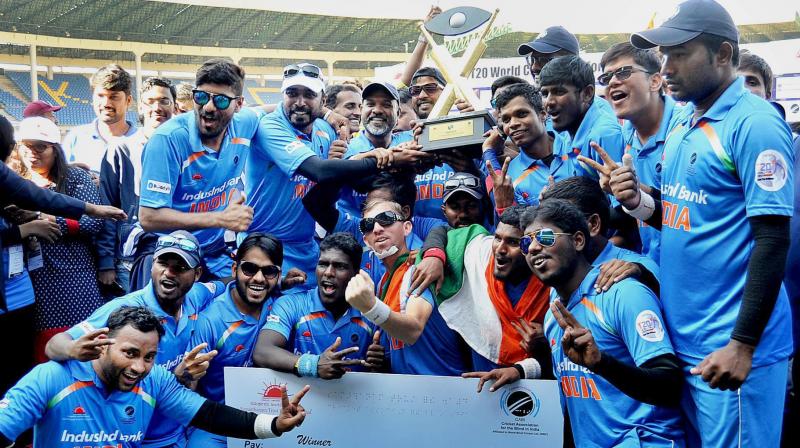
Blind cricket: A game better than the usual

Amidst all the hopes for India winning the ICC World Cup 2019, there lies a hidden story about the Indian National Blind Cricket team which has won the Blind Cricket World Cup four times.
A tournament played among six countries: India, Pakistan, Australia, Bangladesh, United Arab Emirates and Nepal, this is an initiative to promote the skills of the differently-abled. The people’s popular |India vs Pakistan match enjoyed its hype but we failed to notice that our blind cricket team won their 2018 World Cup title against Pakistan to retain the crown of the champions.
An idea that is not much known to us, has won four ODI World Cups in six years. The team has also aced the Twenty20 World Cup title twice in 2012 and 2017. Even the 2016 Asia Cup was written in the name of this team under the captaincy of Ajay Kumar Reddy. Known as one of the most consistent blind cricketers, Ajay has played 57 ODIs and T20s as there are no test matches in blind cricket. There is no record of his career total runs; however, he has picked up 110 wickets and hit 12 centuries.
Also read: WC 2019: Six partnerships that would mint money this season
How is blind cricket played?
Blind cricket follows the standard cricket match rules but it comes with modifications made especially to facilitate the blind players. Firstly, the players are categorized into B1 (fully blind), B2 (partially blind) and B3 (partially sighted). They are given runners according to the category in which they fall.
Bowling is always underarm and the ball used is filled with noise-prodcuing elements that could be heard by the fully blind batsmen and fielders. At the time of delivery, the arm needs to be below the shoulder. Failing this will result in a no ball. The delivery should to pitch at least twice but it should not roll.
When the bowler shouts “Ready” before releasing the ball, the batsman must respond with a “Yes”. The umpire would declare the ball bowled a ‘no ball’ if these calls are mistimed to be too early or late.
While releasing the ball, the bowler shouts “Play” and just by hearing the noise made by the ball, a batsman would hit it. However, there are exemptions given to B1 players such that every run they score is doubled. Even the one bounce caught-out method is allowed to B1 fielders.
The team comprises of 11 players with four B1 players, three B2 players and four B3 players which includes runners for the B1 category players too.
Also read: Shout out for the Indian Captain ranked 100 by Forbes
How do they classify sights?
B1 players have no light perception in either of their eye and fail to recognize even the shape of a hand at any given distance. B2 players are ranked from their ability to recognize the shape of a hand up to any visual field of less than five degrees in the better eye after correction. A B3 players visual acuity starts from 2/60 up to 6/60 or a visual field of less than 20 degrees in the better eye after correction.
How to identify the players on the field?
Players with a white wrist band worn on their right wrist or a white stripe on the right upper arm of their jersey can be identified as B1 players. As for B2 players, a red wrist band worn on the right wrist or two white stripes in the same place as B1 players distinguishes their identity. B3 players, wear a blue wrist band on the right wrist or three white striped jerseys, on their right upper arm.
Also read: This WC season cricket fans turn to virtual fields to earn fast bucks
What are the equipments used?
The ball: A 3 mitre clean ball, supplied by Blind Cricket England and Wales (BCEW), is filled with ball bearings that make noise and the players follow the direction of that sound to play. The captain is supposed to request to clean the ball after every 10 overs.
The bat: A regular bat is used without any alterations.
The stumps: The wickets are 10 inches in size and a fixed 35 inches above the ground. Bails, that are very important in standard cricket, are not used in this case. The three stumps used are usually white but on request even the orange ones can be used.
The pitch and ground: The pitch should preferably be artificial or one prepared with grass like a strip. The boundary shall be a maximum of 50 yards and a minimum of 40 yards from the centre stump at each end of the pitch. It shall be marked by a rope, marked line or plastic markers.
The dress code: All teams must play in coloured kits and should avoid wearing white clothes. A player can be retired by the umpire if the opposing team complains about his clothing. The identifications for players of each category should be worn at all times while they are on the field.
Also watch: Fantasy Cricket: The future of sports
Blind cricket requires more than usual teamwork as the levels of vision among the players varies and need utmost trust and concentration. It is also because much depends on hearing and players must focus on the noise from the ball and cut out the ambience sounds. Such level of passion needs to be admired and so, even if India doesn’t win World Cup this year we have something to celebrate.

